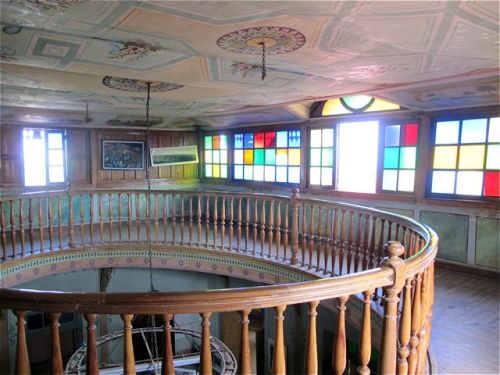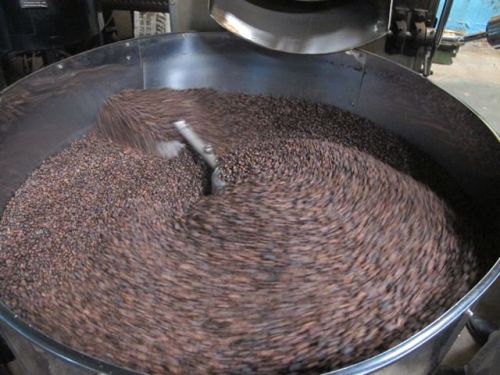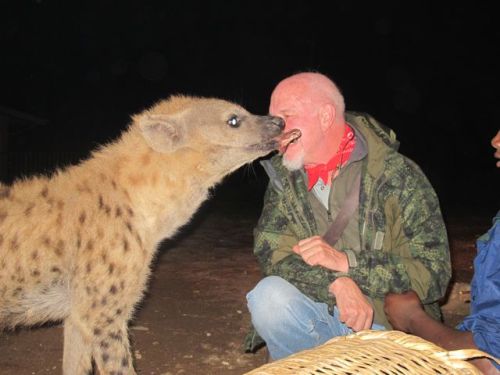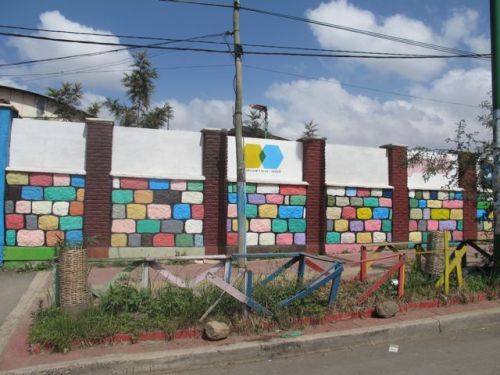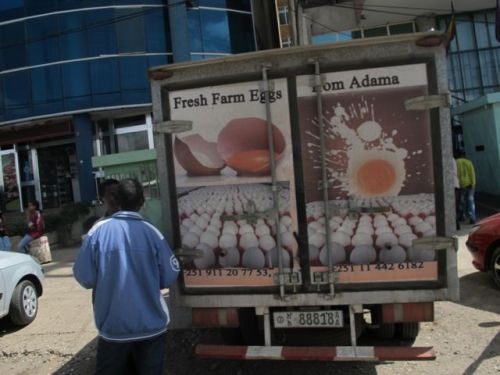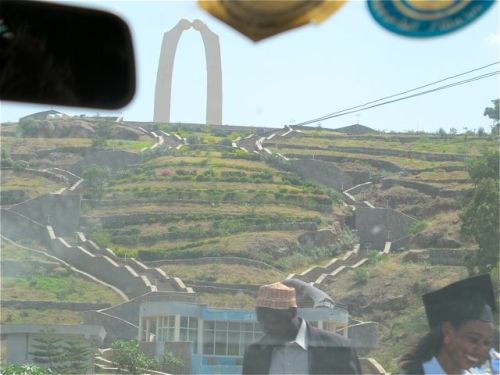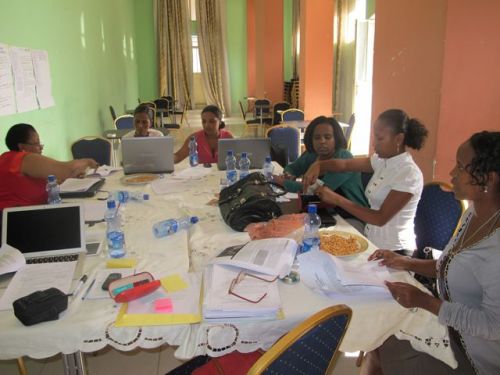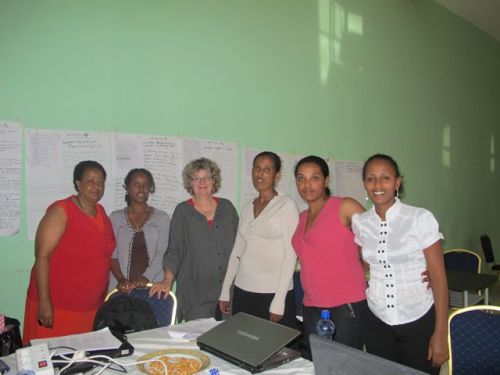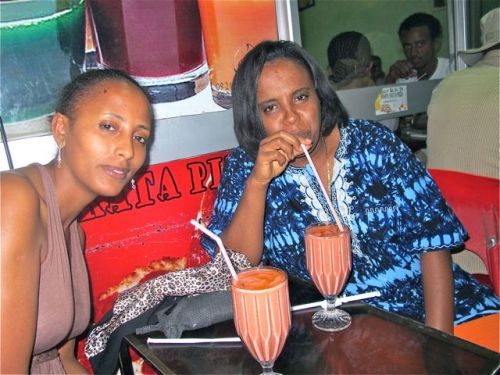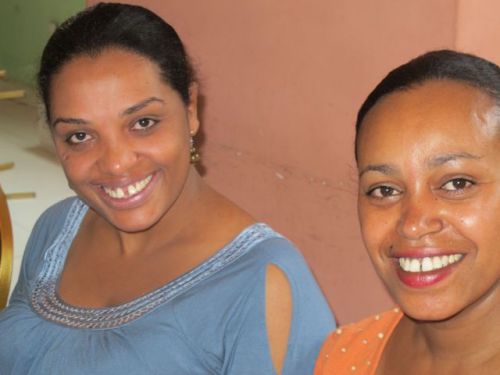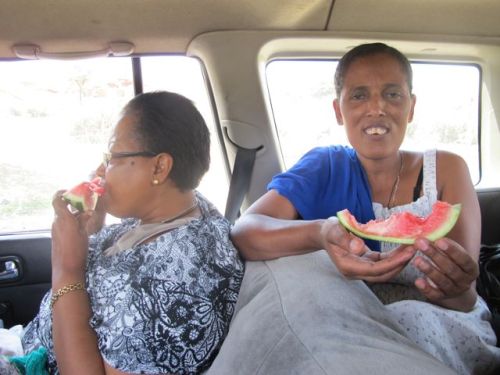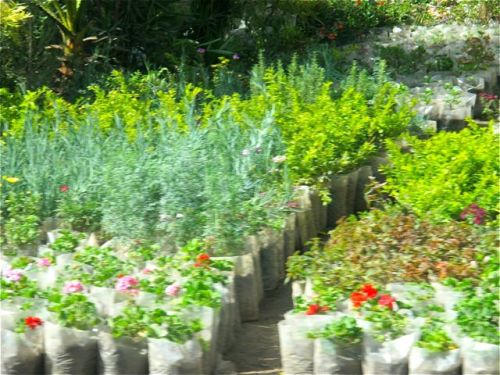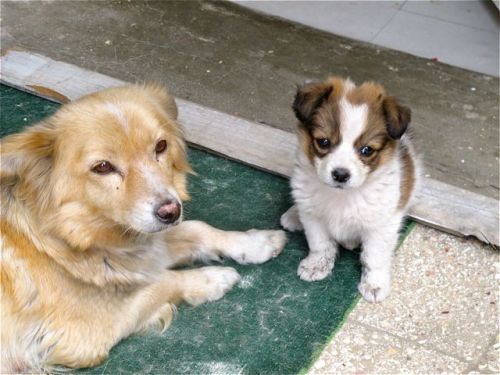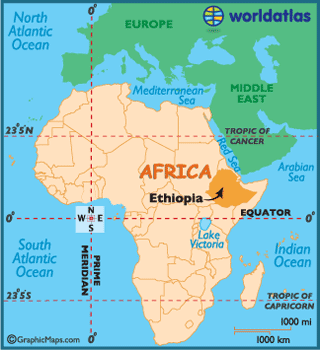The Ethiopian Airlines flight landed smoothly and on time and as we stepped out into the sweltering heat of Dire Dawa a man with a sign saying “Welcome Marian and Howard” immediately packed us into his minibus and drove us up into the much cooler mountains lush with crops and intricate stone terracing. I was pleased that “Howard” aka “Howie” decided to join me on this expedition – he is a Canadian volunteer who’s been here for about 3 months now. He has lived in many parts of Africa, Asia and the Caribbean so it was fun to share this experience with a seasoned traveler who also happens to be a “foodie” like me! He and his housemate Mingfei Sun, a young IT volunteer from China, will be inheriting a lot of my kitchen stuff later on this week when I leave Ethiopia and I have no doubt this will advance their culinary adventures… Maize, coffee, khat are the major income generators in this area
Maize, coffee, khat are the major income generators in this area
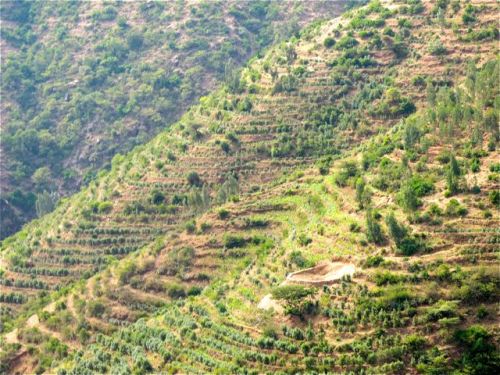 Harar is located in the Oromia region of Ethiopia, about 525 km from Addis Ababa and 43 km from the lowland and very hot city of Dire Dawa. It take less than an hour to fly and 8-10 hours by road
Harar is located in the Oromia region of Ethiopia, about 525 km from Addis Ababa and 43 km from the lowland and very hot city of Dire Dawa. It take less than an hour to fly and 8-10 hours by road
 Closer to Harar we sped past a lake that is apparently great for bird life
Closer to Harar we sped past a lake that is apparently great for bird life
 Biniyam, our terrific guide, met us at the gate to the old city of Harar, know as Jagul and led us down the narrow labyrinth of streets to Rewda Guest House to drop off our backpacks
Biniyam, our terrific guide, met us at the gate to the old city of Harar, know as Jagul and led us down the narrow labyrinth of streets to Rewda Guest House to drop off our backpacks
 I had seen pictures of this traditional Harari house from other volunteers, but you really have to see it to believe it!
I had seen pictures of this traditional Harari house from other volunteers, but you really have to see it to believe it!
There are about 100 of these family houses still in operation in Jagul and each one has the same configuration with platforms at different levels for various household members to sit ( we won’t dwell on the male superiority embedded in this…). The walls hold the treasured baskets of the family, made by the women, some of the largest taking months to complete. A girl needed to make a certain number of various types, including” Mother-in-Law” baskets prior to marriage. A more recent addition is the colourful enamel ware from Asia that seems to blend in perfectly.
 The carpets are imports from the middle east but Biniyam flipped one up to show us an original woven carpet underneath
The carpets are imports from the middle east but Biniyam flipped one up to show us an original woven carpet underneath
 The four large black containers on the shelf are the family “bank” originally containing coins, jewelry, incense and seeds
The four large black containers on the shelf are the family “bank” originally containing coins, jewelry, incense and seeds
 We flipped a coin and I got the upper room in the main house and Howie got one in the courtyard next to the shared bathroom
We flipped a coin and I got the upper room in the main house and Howie got one in the courtyard next to the shared bathroom
Rewda’s Guest House has about 3-4 rooms for rent within the family compound. Normally she serves a delicious breakfast but because it is now Ramadan we paid a bit less and ate out in the new town. Harar is considered the spiritual heart of Ethiopia’s large Islamic community and the fourth holiest city of Islam. Almost the entire population of Jagul is Muslim, although there is one Ethiopian Orthodox Christian church and one Catholic church in the city. We were treated to late night chanting (with a bit of excessive drumming in my opinion) but it did add to the authenticity of experience!
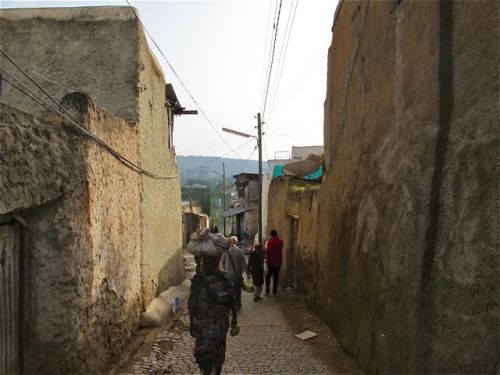 Every one of the hundreds of narrow streets offers fascinating views – it felt like going back in time (if one blanked out the electric wires and satelite dishes!)
Every one of the hundreds of narrow streets offers fascinating views – it felt like going back in time (if one blanked out the electric wires and satelite dishes!)
 Time for lunch at the atmospheric Hirut Restaurant where the chef puts on a good show in the open kitchen
Time for lunch at the atmospheric Hirut Restaurant where the chef puts on a good show in the open kitchen
 Voila – Special Tibs, made with goat meat served with awaze paste and a basket of bread.injera to scoop it up
Voila – Special Tibs, made with goat meat served with awaze paste and a basket of bread.injera to scoop it up
 After lunch we took a tuk-tuk above the old town to get a birds eye view of the wall built in the 1560’s
After lunch we took a tuk-tuk above the old town to get a birds eye view of the wall built in the 1560’s
 Biniyam estimates about 40,000 people currently live in Jagul
Biniyam estimates about 40,000 people currently live in Jagul
 On the hillside I was pleased to get close up to some meskel daisies; these are sold for the September 27th Orthodox Christian Meskel celebrations all over Ethiopia but I had never before seen them growing in the wild
On the hillside I was pleased to get close up to some meskel daisies; these are sold for the September 27th Orthodox Christian Meskel celebrations all over Ethiopia but I had never before seen them growing in the wild
 Then we proceeded down to the Buda Gate, one of the 5 main gates of the old city
Then we proceeded down to the Buda Gate, one of the 5 main gates of the old city
 Harari women dress very colourfully so every view is a visual feast
Harari women dress very colourfully so every view is a visual feast
 Shiro and berbere among the many tasty blends available by the kilo – when I asked for a small handful of Danakil salt and a bit of tikur azmut (black cumin) to bring home, they didn’t charge me because they consider these amounts too small!
Shiro and berbere among the many tasty blends available by the kilo – when I asked for a small handful of Danakil salt and a bit of tikur azmut (black cumin) to bring home, they didn’t charge me because they consider these amounts too small!
 Fire finches enjoy free samples too!
Fire finches enjoy free samples too!
 Biniyam squeezed some beans (goolow) to show us how these oily beans are used for their greasing the traditional clay injera griddles. I was able to finally understand what Dirib had tied to explain to me in Woldia when she showed me how to make injera; at the time I had been confused when she indicated that the grease she had in an old tin was from a bean!
Biniyam squeezed some beans (goolow) to show us how these oily beans are used for their greasing the traditional clay injera griddles. I was able to finally understand what Dirib had tied to explain to me in Woldia when she showed me how to make injera; at the time I had been confused when she indicated that the grease she had in an old tin was from a bean!
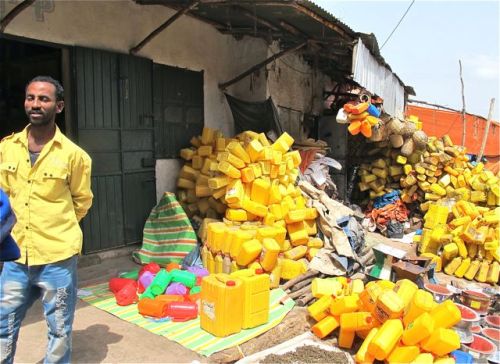 This market is huge – here a whole section is dedicated to re-cycling the ubiquitous yellow oil containers
This market is huge – here a whole section is dedicated to re-cycling the ubiquitous yellow oil containers
 When you are fasting from sun up to sun down an afternoon nap can be very tempting!
When you are fasting from sun up to sun down an afternoon nap can be very tempting!
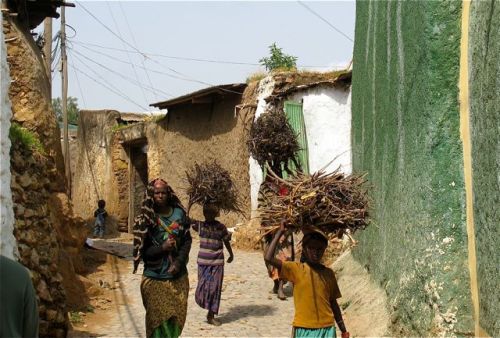 Women carrying heavy loads of wood
Women carrying heavy loads of wood
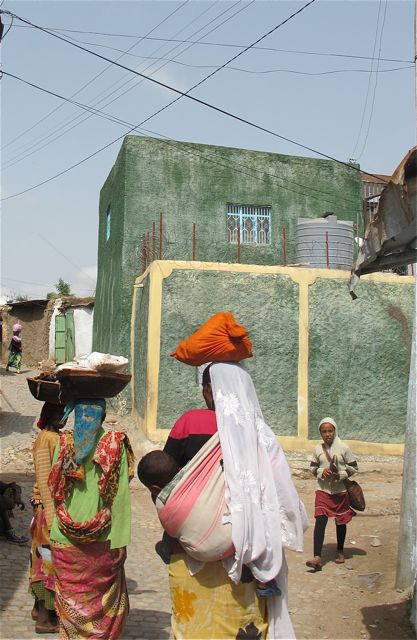 I saw many more women carrying things on their heads here than anywhere else I had been in Ethiopia
I saw many more women carrying things on their heads here than anywhere else I had been in Ethiopia
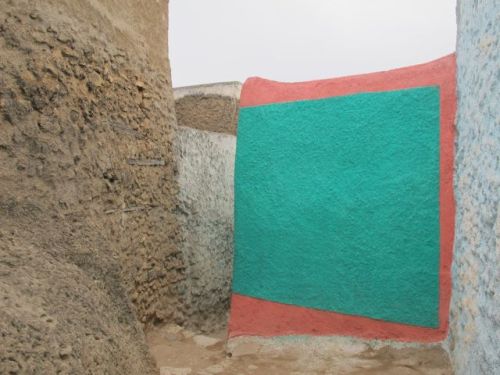 Lovely colourful walls presented themselves at almost every turn
Lovely colourful walls presented themselves at almost every turn
 Harar has 90+ tiny mosques as well as several large ones and is said to have the largest concentration of such shrines in the world
Harar has 90+ tiny mosques as well as several large ones and is said to have the largest concentration of such shrines in the world
 The Indian influence is seen on a number of houses with interesting balconies and roof finials
The Indian influence is seen on a number of houses with interesting balconies and roof finials
 The Rimbaud Museum in a building restored with funds form France to celebrate the 12 years French poet Arthur Rimbaud spent in Harar in the late 1800’s
The Rimbaud Museum in a building restored with funds form France to celebrate the 12 years French poet Arthur Rimbaud spent in Harar in the late 1800’s
 An interesting collection of old photos
An interesting collection of old photos
 Including for the massive kites that circle overhead!
Including for the massive kites that circle overhead!
 This is the Blacksmith area closed now for Ramadan
This is the Blacksmith area closed now for Ramadan
 An old wall being restored in traditional fashion
An old wall being restored in traditional fashion
Harar is a UNESCO World Heritage site and awarded a Peace Prize in 2002-2003 for being a role model of different cultures and religions living in harmony
 The main Harar gate with the UNESCO and Peace Prize plaques
The main Harar gate with the UNESCO and Peace Prize plaques
 Ancient stone steps lead to a mosque
Ancient stone steps lead to a mosque
 Isn’t it time for some coffee?
Isn’t it time for some coffee?
 Grinding and packing the buna by the kilo – yes there is some coming home to Vancouver with me!
Grinding and packing the buna by the kilo – yes there is some coming home to Vancouver with me!
 Nure Roasted Harar Coffee – famous all over Ethiopia!
Nure Roasted Harar Coffee – famous all over Ethiopia!
 Traditional basket replica outside a mosque
Traditional basket replica outside a mosque
 As night falls the hyenas come out. This has been a tourist attraction of Harar since the 50’s or 60’s
As night falls the hyenas come out. This has been a tourist attraction of Harar since the 50’s or 60’s
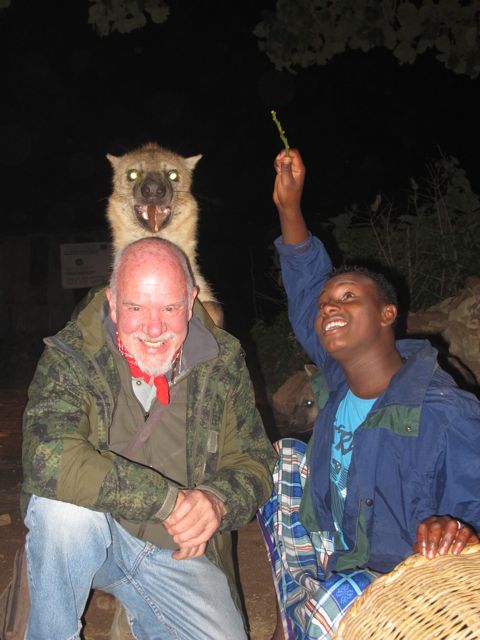 Howie and hungry hyena with meat in his mouth
Howie and hungry hyena with meat in his mouth
 I decide its not that scary but ask for a longer stick
I decide its not that scary but ask for a longer stick
 Then get braver and make him do tricks
Then get braver and make him do tricks
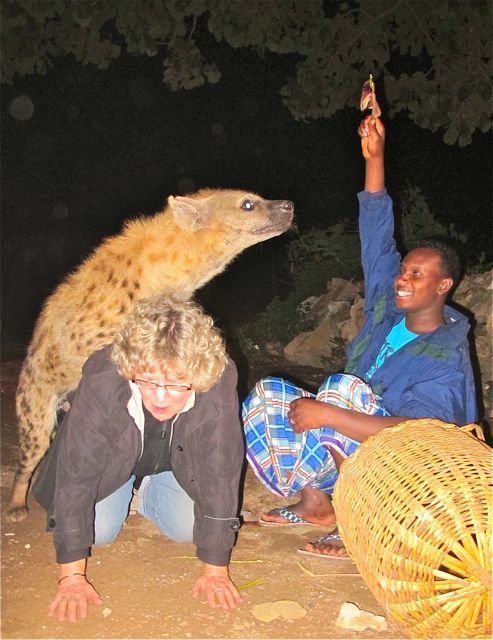 But realize that hyenas are really heavy (males weight 80-85 kg and females 85-90) and I don’t want it pressing on my back so say “Get this thing off me – beka (enough) and woraj (stop)” Hey but I DID it! His name was Willie I think – all these hyenas have names!
But realize that hyenas are really heavy (males weight 80-85 kg and females 85-90) and I don’t want it pressing on my back so say “Get this thing off me – beka (enough) and woraj (stop)” Hey but I DID it! His name was Willie I think – all these hyenas have names!
 In daylight we see the site of the hyena feeding – a shine to a Muslim saint – these often are build with sycamore trees planted on top that eventually merge with the shrine as this one has…
In daylight we see the site of the hyena feeding – a shine to a Muslim saint – these often are build with sycamore trees planted on top that eventually merge with the shrine as this one has…
 Next morning Biniyam picks us up to go to eat ful at his favourite spot and I down a double makeeto in anticipation of another big day of sight seeing
Next morning Biniyam picks us up to go to eat ful at his favourite spot and I down a double makeeto in anticipation of another big day of sight seeing
 We hop a line taxi to Aweday about 5 km away and the site of Ethiopia’s largest khat market – that’s a typical khat bundle being carried on her head. The khat is wrapped in wet leaves to keep it moist…I decide the architect of the building on the left must have been chewing!
We hop a line taxi to Aweday about 5 km away and the site of Ethiopia’s largest khat market – that’s a typical khat bundle being carried on her head. The khat is wrapped in wet leaves to keep it moist…I decide the architect of the building on the left must have been chewing!
 Entering the khat market into another world!
Entering the khat market into another world!
 Khat must be consumed within 48 hours and this place bustles 24-7 with trucks speeding off to Djibouti and Somaliland with top quality khat. The fresh green leaf is a mild stimulant that is legal in Ethiopia, Eritrea, Yemen and Somalia
Khat must be consumed within 48 hours and this place bustles 24-7 with trucks speeding off to Djibouti and Somaliland with top quality khat. The fresh green leaf is a mild stimulant that is legal in Ethiopia, Eritrea, Yemen and Somalia
 We climbed up the stairs for a better view of the massive scene and this girl asked me to take her photo
We climbed up the stairs for a better view of the massive scene and this girl asked me to take her photo
 Room after room is full of chat being sorted and bundled by men
Room after room is full of chat being sorted and bundled by men
 Biniyam displays a bundle of the best, costing about 1000 Birr ($60 CDN)
Biniyam displays a bundle of the best, costing about 1000 Birr ($60 CDN)
 We were told that khat is a big income generator for Ethiopia and because it grows faster than coffee and is worth more it is taking over coffee production in the region. And no, I did not try any – my metabolism is already speedy enough!
We were told that khat is a big income generator for Ethiopia and because it grows faster than coffee and is worth more it is taking over coffee production in the region. And no, I did not try any – my metabolism is already speedy enough!
 Back in Jagul we continued to tour. This is a house that future Emperor Haile Selassie is said to have lived in until age 18
Back in Jagul we continued to tour. This is a house that future Emperor Haile Selassie is said to have lived in until age 18
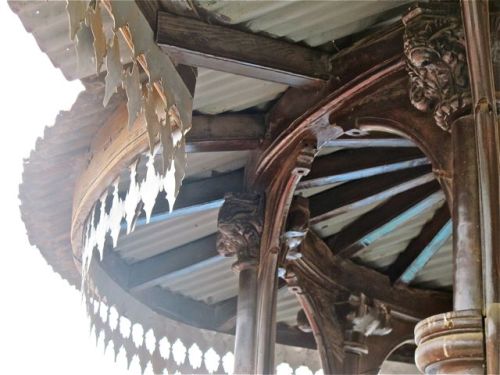 Now being transformed into a museum to preserve/display the history of Harar
Now being transformed into a museum to preserve/display the history of Harar
 For lunch we met a couple of fellow volunteers, Helen and Mark Anthony, from nearby Haromaya University for a leisurely lunch at a local ferenji spot called Fresh Touch in the new town, then meandered back to Rewda’s to relax a bit in the courtyard and watch the kids playing. When we got there a goat had just been slaughtered at the gate so we had to wait for the blood to be hosed away before we could get in…!
For lunch we met a couple of fellow volunteers, Helen and Mark Anthony, from nearby Haromaya University for a leisurely lunch at a local ferenji spot called Fresh Touch in the new town, then meandered back to Rewda’s to relax a bit in the courtyard and watch the kids playing. When we got there a goat had just been slaughtered at the gate so we had to wait for the blood to be hosed away before we could get in…!
 A future hyena tamer practices on the cat with the freshly slaughtered goat meat!
A future hyena tamer practices on the cat with the freshly slaughtered goat meat!
Later on we wandered back to Hirut for dinner and conversation with Biniyam – since he knows every detail of his city and the history of Ethiopia and has become very well aware of many parts of the world from his interactions with tourists from all over, he is a great conversationalist. At 25 he has a bright future ahead of him I am sure. Every aspect of our visit was a delight; he seemed to know exactly what tell us and what to show us, tailoring the walks to suit our interests and ensuring we did not miss any highlights that if we were simply wandering about on our own we would surely have missed.
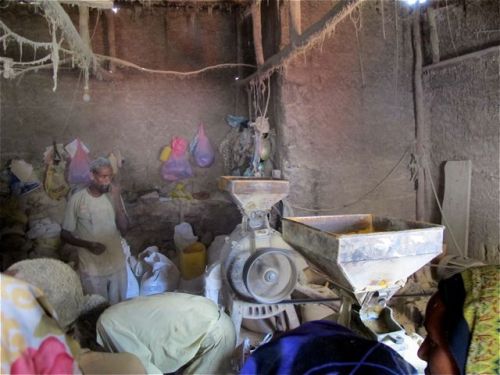 Like a peek inside a flour mill
Like a peek inside a flour mill
 Or where to find the expert who makes fetira in this giant griddle
Or where to find the expert who makes fetira in this giant griddle
 Sunday morning we set off for another cafe to sample fetira with egg and honey and spicy chechebsa, both very tasty!
Sunday morning we set off for another cafe to sample fetira with egg and honey and spicy chechebsa, both very tasty!
 Then took a walk through the peaceful early morning streets to the mango market – it is mango season and donkeys are the main transporters using these attractive leather saddles
Then took a walk through the peaceful early morning streets to the mango market – it is mango season and donkeys are the main transporters using these attractive leather saddles
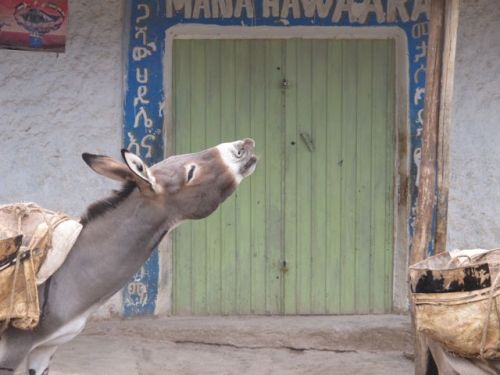 This donkey had a loud opinion!
This donkey had a loud opinion!
 Back inside the old city past another one of the gates near the mango market
Back inside the old city past another one of the gates near the mango market
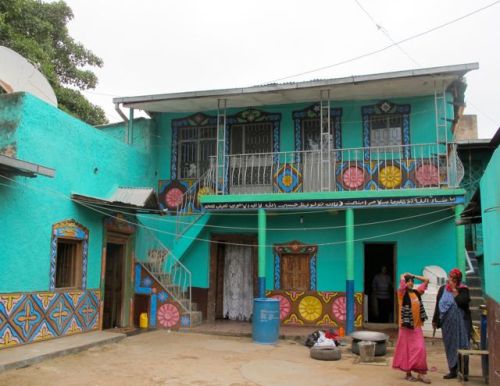 Inside a well known Harari family compound attached to a mosque
Inside a well known Harari family compound attached to a mosque
 Finally we arrive at the tomb of the man who built the Harar wall – Ibn Nur al Mujahadeen
Finally we arrive at the tomb of the man who built the Harar wall – Ibn Nur al Mujahadeen
Domes can tell you if the person was a warrior, politician, scholar or spiritual protector. They have 99 protrusions to indicate the 99 names of Allah and also for practical reasons to maintain the structure by allowing climbing for upkeep and painting.
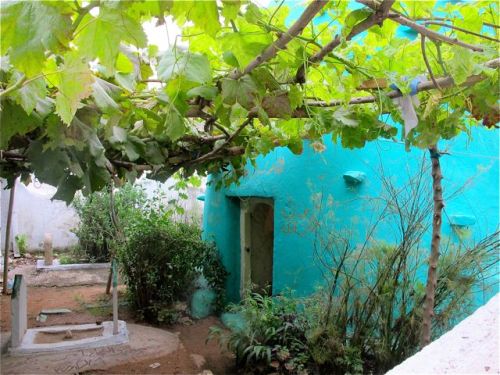 I had a scarf to cover my head and took off my shoes to see inside – this tomb is surrounded by other graves
I had a scarf to cover my head and took off my shoes to see inside – this tomb is surrounded by other graves
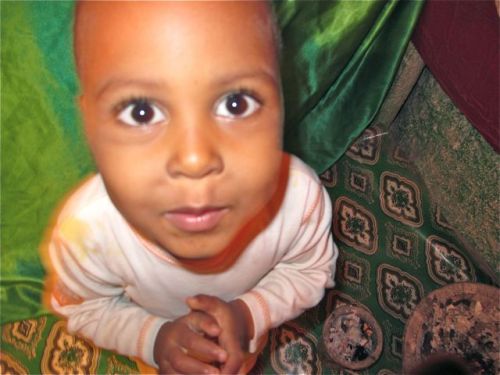 This little guy came in with me!
This little guy came in with me!
Late morning we hustled back to collect our bags for the drive back to the Dire Dawa airport and the flight home to Addis after a great weekend in Harar.
 Statue of Ras Mekonnen, father of Emperor Haile Selassie and the man appointed by Emperor Menelik to rule Harar after defeating Emir Abdullah at the Battle of Chelenko in 1887
Statue of Ras Mekonnen, father of Emperor Haile Selassie and the man appointed by Emperor Menelik to rule Harar after defeating Emir Abdullah at the Battle of Chelenko in 1887
 Final photo as we head back to the airport – thanks Biniyam for an absolutely perfect Harar tour!
Final photo as we head back to the airport – thanks Biniyam for an absolutely perfect Harar tour!
NOTE: Anyone wanting to contact tourist guide Biniyam can email him at feresmegala@gmail.com or call 0911 076 059



